A Cost-Effective IoT System for Monitoring Indoor Radon Gas Concentration
Abstract
:1. Introduction
- It is able to collect data from Commercial Off-The-Shelf (COTS) radon sensors and transmit them to a central server where they can be stored and processed.
- It offers a remote user-friendly web interface that shows the current and historic series of the radon concentration values.
- The system can be configured to set alert thresholds and sampling frequencies to react to abnormal radon gas concentrations.
- It is able to send remote alerts to the subscribed users to warn them about exceeding radon concentration levels.
- It can activate mitigation devices (e.g., forced ventilation) to decrease radon gas concentration.
2. Related Work
2.1. Types of Radon Detection Devices
- Sensors based on electret ion chambers: These are passive devices that act as integrating detectors that estimate the average radon gas concentration [34]. Such devices have shown excellent accuracy, but standard operation procedures must be followed to avoid interference from background gamma radiation [35] or the presence of dust in the electrets [36].
- Solid-state silicon detectors: Most electronic integrating devices are able to count the alpha particles emitted by radon and its decay products by making use of a solid-state silicon detector and a diffusion chamber. These devices have two main restrictions. First, they usually require long integration periods (more than two days), because of the small dimensions of their diffusion chambers. Second, their measurements can be altered in high humidity environments [37].
- Scintillation cells and current or pulse ionization chambers: These are mainly used for building continuous radon monitoring systems. Such systems collect air through a small pump and diffuse it into the sensing chamber, where measurements are performed during certain time intervals. Their features change depending on the sensing technique, but all of them usually share a common drawback: they require being calibrated periodically to guarantee accuracy and reliability.
- It updates air samples and readings every hour.
- It provides short-term readings performed on the average of the last seven days.
- It collects long-term readings that are calculated as the average since the last reset of the device.
- It contains a menu button that toggles between short and long term. It also switches off the sound alarm and, when pressed during a certain amount of time, it restarts the sensor memory.
- To verify accuracy and reliability, the sensor auto-checks its internal state every 24 h.
- Guaranteed accuracy: ± 20% or ± 37 Bq/m (the highest of both).
- Typical accuracy: ± 10%.
- Sensor type: diffuse junction photodiode.
- It is actually small in comparison to other radon monitoring tools (its dimensions are 12.0 cm × 7.9 cm × 5.3 cm).
2.2. Academic Monitoring Systems
2.3. Mitigation Systems
- Active soil suction (active sub-slab suction or sub-slab depressurization): This is considered the most reliable and common radon reduction method [8]. It consists of drawing the radon below a building through one or more pipes. Such pipes are inserted through the floor slab into the soil or rock underneath and allow for venting the radon to the air above the home. In homes where the foundations are built with hollow block walls, sub-slab suction can be used in conjunction with block-wall suction to depressurize the block wall. There is also a passive sub-slab suction variety that depends on natural air flows, but it is usually not as effective as active sub-slab suction when there is a high radon gas concentration.
- Perforated pipe, drain tile or sump-hole suction: These systems direct water away from the home foundations by suctioning it through pipes, tiles or by using sump pumps [53].
- Submembrane suction: This is a technique usually applied to crawlspace homes that consists of covering the earth floor with a high-density plastic sheet and then installing a pipe and a fan to draw the radon from under the sheet in order to vent it to the outdoors [54].
- Sealing cracks and openings in the foundations: Theoretically, this method prevents the radon from flowing into the building, but it has to be used in conjunction with another technique, since its use alone has not been shown to lower radon levels significantly.
- Home pressurization or use of air-to-air heat exchangers: These techniques consist of installing devices (a fan or heat exchangers) that blow outdoor air into the house. In the case of home pressurization, the incoming air creates pressure that prevents radon from entering the house, while air exchangers generate a heating or cooling air flow that helps to vent the house.
- Use of natural ventilation: Opening windows, doors and vents creates air flow that mixes outdoor and indoor air, which decreases radon concentration levels. However, note that natural ventilation is only a temporary solution, since it influences air conditioning and home security.
2.4. Analysis of the Related Work
- There are different commercial devices able to detect radon gas concentration, but they are either too expensive for the average householder (accurate readers are available from €1700), slow (e.g., long-term kits) or they do not provide Internet connectivity to access the collected values remotely (e.g., Rstone or Safety Siren Pro Series 3).
- Academic systems are a step ahead of commercial devices in terms of features, but it was found that none were explicitly designed as IoT devices.
- There is a wide range of mitigation systems to reduce radon gas concentration, but such systems are actually either passive approaches (e.g., sealing) or they are not usually connected to radon monitoring devices to act in a smart way.
3. Design of the System
3.1. Architecture
3.2. Sensor Subsystem
- A WeMos Mini D1: This is a ESP8266-based board that provides USB-to-serial connectivity and multiple I/O pins to control other devices.
- A 5-V relay and a transistor: These are able to switch the radon sensor on and off remotely in case any problem arises.
- A voltage regulator and a DC power jack: These enable plugging in the official power adapter of the radon sensor (which works at 18 VDC) and stepping down the voltage to 5 V.
- A 16-to-one mux (CD74HC4067): This is actually inside the radon gas sensor. It is used because the display makes use of twelve parallel signals to communicate through a strobe encoding: seven of them are used for controlling the number shown in seven segments, and five strobe signals select the four digits. Since the number of input pins of the ESP8266 is reduced, the mux needs to be used as shown in Figure 4.
3.3. Service Subsystem
3.4. Visualization Subsystem
3.5. Communication Protocols
4. Implementation
4.1. Implemented Features
- It shows the current short- and long-term radon gas concentration values.
- It plots the historical evolution of the concentration of radon in order to detect trends.
- It is possible to add alerts to the system depending on a threshold that indicates the minimum radon gas concentration. Once the threshold is exceeded, an alert is notified to the user. The configured alerts can be checked with a certain frequency, allowing for sending notifications once an hour, once a day, once a week or once a month.
- Alerts are shown in a specific section of the web dashboards, but they can also be notified to the user through different communication systems (e.g., email, Telegram, SMS).
- The dashboard also shows relevant daily statistics like the mean, minimum and maximum radon gas concentration values.
- It allows for adding multiple radon sensors to the system so that different users can access them in parallel.
- Sensor nodes can be configured remotely, so a technician does not have to go to the place where the sensor is installed to reprogram the firmware.
- Two APIs are provided (Sensor and User API) so that third-parties can interact with the system and develop their own software and add new features to the system.
4.2. Implemented APIs
4.2.1. Sensor API
4.2.2. User API
- GET/history allows obtaining the stored values in a given time range. Three parameters are required: the sensor identifier (SensorID) and the start and end dates.
- GET/threshold allows obtaining the configured alert levels that trigger the different mitigation actions. There are also DELETE and POST methods on this endpoint, which make it possible to eliminate and create new alerts, respectively.
4.3. Visualization and Control Software
4.4. Notification Service
5. Experiments
5.1. Radon Gas Concentration
5.1.1. Urban Home
5.1.2. Galician Rural Home
5.1.3. Research Lab
5.2. Interference Analysis
5.2.1. WiFi Interference under Regular Use
5.2.2. SoC Interference
5.2.3. High-Traffic WiFi
6. Conclusions
Author Contributions
Funding
Conflicts of Interest
Abbreviations
| API | Application Programming Interface |
| AUV | Autonomous Underwater Vehicle |
| COTS | Commercial Off-The-Shelf |
| LLD | Lower Limit of Detection |
| LRAD | Long-Range Alpha Detector |
| NTP | Network Time Protocol |
| REST | REpresentational State Transfer |
| RTC | Real-Time Clock |
| SoC | System-on-Chip |
| UHF | Ultra-High Frequency |
| WHO | World Health Organization |
References
- United Nations Science Committee on the Effects of Atomic Radiation. Ionizing Radiation: Sources and Biological Effects; United Nations Science Committee on the Effects of Atomic Radiation: New York, NY, USA, 1982.
- Wilkenin, M. Radon in the Environment; Elsevier: Amsterdam, The Netherlands, 1990. [Google Scholar]
- Baskaran, M. Radon: A Tracer for Geological, Geophysical and Geochemical Studies; Springer: Cham, Switzerland, 2016. [Google Scholar]
- World Nuclear Organization. Nuclear Radiation and Health Effects. Available online: http://www.world-nuclear.org/information-library/safety-and-security/radiation-and-health/nuclear-radiation-and-health-effects.aspx (accessed on 1 June 2018).
- World Health Organization. WHO Handbook on Indoor Radon: A Public Health Perspective; WHO Press: Geneva, Switzerland, 2009. [Google Scholar]
- World Health Organization. Radon and Health Fact Sheet. Available online: http://www.who.int/mediacentre/factsheets/fs291/en/ (accessed on 15 May 2018).
- Bruno, R.C. Sources of Indoor Radon in Houses: A Review. J. Air Pollut. Control Assoc. 1983, 33, 105–109. [Google Scholar] [CrossRef] [Green Version]
- United States Environmental Protection Agency (US EPA). Consumer’s Guide to Radon Reduction; US EPA: Washington, DC, USA, 2013.
- Health Canada, Radon: Is It in Your Home? Available online: https://www.canada.ca/en/health-canada/services/environmental-workplace-health/reports-publications/radiation/radon-your-home-health-canada-2009.html (accessed on 1 June 2018).
- EU Directive 2013/59/Euratom. Available online: https://ec.europa.eu/energy/sites/ener/files/documents/CELEX-32013L0059-EN-TXT.pdf (accessed on 1 June 2018).
- Rericha, V.; Kulich, M.; Rericha, R.; Shore, D.L.; Sandler, D.P. Incidence of leukemia, lymphoma, and multiple myeloma in Czech uranium miners: A case-cohort study. Environ. Health Perspect. 2006, 114, 818–822. [Google Scholar] [CrossRef] [PubMed]
- Blanco-Novoa, Ó.; Fernández-Caramés, T.M.; Fraga-Lamas, P.; Vilar-Montesinos, M.A. A Practical Evaluation of Commercial Industrial Augmented Reality Systems in an Industry 4.0 Shipyard. IEEE Access 2018, 6, 8201–8218. [Google Scholar] [CrossRef]
- Fernández-Caramés, T.M.; Fraga-Lamas, P.; Suárez-Albela, M.; Vilar-Montesinos, M. A Fog Computing and Cloudlet Based Augmented Reality System for the Industry 4.0 Shipyard. Sensors 2018, 18, 1798. [Google Scholar] [CrossRef] [PubMed]
- Fraga-Lamas, P.; Fernández-Caramés, T.M.; Blanco-Novoa, Ó.; Vilar-Montesinos, M.A. A Review on Industrial Augmented Reality Systems for the Industry 4.0 Shipyard. IEEE Access 2018, 6, 13358–13375. [Google Scholar] [CrossRef]
- Fernández-Caramés, T.M.; Fraga-Lamas, P. A Review on the Use of Blockchain for the Internet of Things. IEEE Access 2018, 6, 32979–33001. [Google Scholar] [CrossRef]
- Fernández-Caramés, T.M.; Fraga-Lamas, P. A Review on Human-Centered IoT-Connected Smart Labels for the Industry 4.0. IEEE Access 2018, 6, 25939–25957. [Google Scholar] [CrossRef]
- Fraga-Lamas, P.; Fernández-Caramés, T.M.; Suárez-Albela, M.; Castedo, L.; González-López, M. A Review on Internet of Things for Defense and Public Safety. Sensors 2016, 16, 1644. [Google Scholar] [CrossRef] [PubMed]
- Fraga-Lamas, P. Enabling Technologies and Cyber-Physical Systems for Mission-Critical Scenarios. May 2017. Available online: http://hdl.handle.net/2183/19143 (accessed on 1 June 2018).
- Suárez-Albela, M.; Fernández-Caramés, T.M.; Fraga-Lamas, P.; Castedo, L. A Practical Evaluation of a High-Security Energy-Efficient Gateway for IoT Fog Computing Applications. Sensors 2017, 17, 1978. [Google Scholar] [CrossRef] [PubMed]
- Hernández-Rojas, D.L.; Fernández-Caramés, T.M.; Fraga-Lamas, P.; Escudero, C.J. Design and Practical Evaluation of a Family of Lightweight Protocols for Heterogeneous Sensing through BLE Beacons in IoT Telemetry Applications. Sensors 2018, 18, 57. [Google Scholar] [CrossRef] [PubMed]
- Fraga-Lamas, P.; Fernández-Caramés, T.M.; Castedo, L. Towards the Internet of Smart Trains: A Review on Industrial IoT-Connected Railways. Sensors 2017, 17, 1457. [Google Scholar] [CrossRef] [PubMed]
- Fernández-Caramés, T.M.; Fraga-Lamas, P.; Suárez-Albela, M.; Castedo, L.; Albela, M.; Castedo, L. A Methodology for Evaluating Security in Commercial RFID Systems, Radio Frequency Identification. In Radio Frequency Identification, 1st ed.; Crepaldi, P.C., Pimenta, T.C., Eds.; INTECH: Rijeka, Croatia, 2016. [Google Scholar]
- Fraga-Lamas, P.; Fernández-Caramés, T.M. Reverse Engineering the Communications Protocol of an RFID Public Transportation Card. In Proceedings of the 2017 IEEE International Conference on RFID (IEEE RFID 2017), Phoenix, AZ, USA, 9–11 May 2017; pp. 30–35. [Google Scholar]
- Barro-Torres, S.J.; Fernández-Caramés, T.M.; González-López, M.; Escudero-Cascón, C.J. Maritime freight container management system using RFID. In Proceedings of the Third International EURASIP Workshop on RFID Technology, La Manga del Mar Menor, Spain, 6–7 September 2010. [Google Scholar]
- Fraga-Lamas, P.; Fernández-Caramés, T.M.; Noceda-Davila, D.; Vilar-Montesinos, M. RSS Stabilization Techniques for a Real-Time Passive UHF RFID Pipe Monitoring System for Smart Shipyards. In Proceedings of the 2017 IEEE International Conference on RFID (IEEE RFID 2017), Phoenix, AZ, USA, 9–11 May 2017; pp. 161–166. [Google Scholar]
- Fraga-Lamas, P.; Fernández-Caramés, T.M.; Noceda-Davila, D.; Díaz-Bouza, M.; Vilar-Montesinos, M.; Pena-Agras, J.D.; Castedo, L. Enabling automatic event detection for the pipe workshop of the shipyard 4.0. In Proceedings of the 2017 56th FITCE Congress, Madrid, Spain, 14–15 September 2017; pp. 20–27. [Google Scholar]
- Fernández-Caramés, T.M.; Fraga-Lamas, P.; Suárez-Albela, M.; Díaz-Bouza, M.A. A Fog Computing Based Cyber-Physical System for the Automation of Pipe-Related Tasks in the Industry 4.0 Shipyard. Sensors 2018, 18, 1961. [Google Scholar] [CrossRef] [PubMed]
- Fraga-Lamas, P.; Noceda-Davila, D.; Fernández-Caramés, T.M.; Díaz-Bouza, M.; Vilar-Montesinos, M. Smart Pipe System for a Shipyard 4.0. Sensors 2016, 16, 2186. [Google Scholar] [CrossRef] [PubMed]
- Suárez-Albela, M.; Fraga-Lamas, P.; Fernández-Caramés, T.M.; Dapena, A.; González-López, M. Home Automation System Based on Intelligent Transducer Enablers. Sensors 2016, 16, 1595. [Google Scholar] [CrossRef] [PubMed]
- Blanco-Novoa, O.; Fernández-Caramés, T.M.; Fraga-Lamas, P.; Castedo, L. An Electricity-Price Aware Open-Source Smart Socket for the Internet of Energy. Sensors 2017, 17, 643. [Google Scholar] [CrossRef] [PubMed]
- Maroni, M.; Seifert, B.; Lindvall, T. Indoor Air Quality: A Comprehensive Reference Book; Elsevier Science: New York, NY, USA, 1995. [Google Scholar]
- Monnin, M.M.; Seidel, J.L. Radon in soil-air and in groundwater related to major geophysical events: A survey. Nucl. Instrum. Methods Phys. Res. 1992, 314, 316–330. [Google Scholar] [CrossRef]
- Vasudevan, L.; McLain, L.; Milton, E. Atmospheric pressure effects on the calibration constant of alpha-track radon detectors. Health Phys. 1994, 66, 318–326. [Google Scholar] [CrossRef] [PubMed]
- Kotrappa, P.; Dempsey, J.C.; Ramsey, R.W.; Stieff, L.R. A practical electret passive environmental radon monitor system for indoor radon measurement. Health Phys. 1990, 58, 461–467. [Google Scholar] [CrossRef] [PubMed]
- Usman, S.; Spitz, H.; Lee, S. Analysis of electret ion chamber radon detector response to 222Rn and interference from background gamma radiation. Health Phys. 1999, 76, 44–49. [Google Scholar] [CrossRef] [PubMed]
- Sun, K.; Majdan, M.; Field, D.W.; Field, R.W. Field comparison of commercially available short-term radon detectors. Health Phys. 2006, 9, 221–226. [Google Scholar] [CrossRef] [PubMed]
- Roca, V.; De Felice, P.; Esposito, A.M.; Pugliese, M.; Sabbarese, C.; Vaupotich, J. The influence of environmental parameters in electrostatic cell radon monitor response. Appl. Radiat. Isot. 2004, 61, 243–247. [Google Scholar] [CrossRef] [PubMed]
- Instrument Manufacturing Division of Pylon Electronics Inc. Official Webpage. Available online: https://pylonelectronics-radon.com/detectors/ (accessed on 22 June 2018).
- Airthings Official Webpage. Available online: https://airthings.com (accessed on 1 June 2018).
- Radiansa Official Webpage. Available online: http://www.radiansa.com (accessed on 1 June 2018).
- Safety Sire Pro Series Official Webpage. Available online: https://www.safetysirenpro.com (accessed on 1 June 2018).
- Miles, A.; Griffin, R.H.; Shen, Y.; Tarr, N.G. A wireless solution for radon gas detection. In Proceedings of the Microsystems and Nanoelectronics Research Conference, Ottawa, ON, Canada, 13–14 October 2009; pp. 88–91. [Google Scholar]
- Morariu, G.; Ogrutan, P.; Kertesz, C.Z.; Alexandru, M.; Pana, G. A novel procedure and apparatus for measuring the radon concentration in air. In Proceedings of the International Conference on Optimization of Electrical and Electronic Equipment, Brasov, Romania, 22–24 May 2008; pp. 221–224. [Google Scholar]
- Shitashima, K.; Miyakawa, K.; Karasawa, K. Development and oceanographic applications of underwater in-situ radon sensor using plastic scintillator. In Proceedings of the IEEE Sensors, Christchurch, New Zealand, 25–28 October 2009; pp. 1729–1732. [Google Scholar]
- Liang, P.; Li, Y. The design of measurement and control system of the radon detection instrument based on MCU. In Proceedings of the International Conference on Electronic and Mechanical Engineering and Information Technology, Harbin, China, 12–14 Agust 2011; pp. 4027–4029. [Google Scholar]
- Griffin, R.H.; Kochermin, A.; Tarr, N.G.; McIntosh, H.; Ding, H.; Weber, J.; Falcomer, R. Sensitive, fast-responding passive electrostatic radon monitor. In Proceedings of the IEEE Sensors, Limerick, Ireland, 28–31 October 2011; pp. 1074–1077. [Google Scholar]
- Bolton, R.D. Radon monitoring using long-range alpha detector-based technology. Procedings of the IEEE Conference in Nuclear Science Symposium and Medical Imaging, Norfolk, VA, USA, 30 October–5 November 1994; Volume 2, pp. 940–944. [Google Scholar]
- Aciu, L.E.; Ogrutan, P.L.; Nicolae, G.; Ursachi, C. Errors in Electronic Radon Gas Monitors due to electromagnetic interferences. In Proceedings of the International Conference on Optimization of Electrical and Electronic Equipment (OPTIM), Bran, Romania, 22–24 May 2014; pp. 144–149. [Google Scholar]
- Cosma, C.; Moldovan, M.; Dicu, T.; Kovacs, T. Radon in Water from Transilvania (Romania). Radiat. Meas. 2008, 43, 1423–1428. [Google Scholar] [CrossRef]
- Blanco-Rodríguez, P.; Fernández-Serantes, L.A.; Otero-Pazos, A.; Calvo-Rolle, J.L.; de Cos Juez, F.J. Radon Mitigation Approach in a Laboratory Measurement Room. Sensors 2017, 17, 1090. [Google Scholar] [CrossRef] [PubMed]
- AlphaGUARD Official Website. Available online: https://www.bertin-instruments.com/product/radon-professional-monitoring/radon-alphaguard/ (accessed on 1 June 2018).
- Li, W.G.; Yao, Q.-Y.; Chen, W.-T. Indoor radon prediction for residential houses. In Proceedings of the International Symposium on Uncertainty Modeling and Analysis and Annual Conference of the North American Fuzzy Information Processing Society, College Park, MD, USA, 17–20 September 1995; pp. 188–191. [Google Scholar]
- Kumar, A.; Kadiyala, A. Assessment and Mitigation of Indoor Radon Problem: A Case Book for Radon Professionals; Bentham Science Publishers: Emirate of Sharjah, UAE, 2014. [Google Scholar]
- Cheremisinoff, N.P. Pollution Control Handbook for Oil and Gas Engineering; Wiley: Hoboken, NJ, USA, 2016. [Google Scholar]
- Espressif Official Website. Available online: http://espressif.com/ (accessed on 1 June 2018).
- MongoDB Official Website. Available online: https://www.mongodb.com (accessed on 1 June 2018).
- American National Standards Institute (ANSI). Protocol for Conducting Measurements of Radon and Radon Decay Products in Homes (MAH-2014); ANSI: Washington, DC, USA, 2014. [Google Scholar]
- American National Standards Institute (ANSI). Performance Specifications for Instrumentation Systems Designed to Measure Radon Gas in Air (MS-PC-2015); ANSI: Washington, DC, USA, 2015. [Google Scholar]
- Kim, Y.-C.; Kim, G.-S. Performance improvement of radon counters. Int. J. Res. Sci. Manag. 2017, 4, 7–13. [Google Scholar]
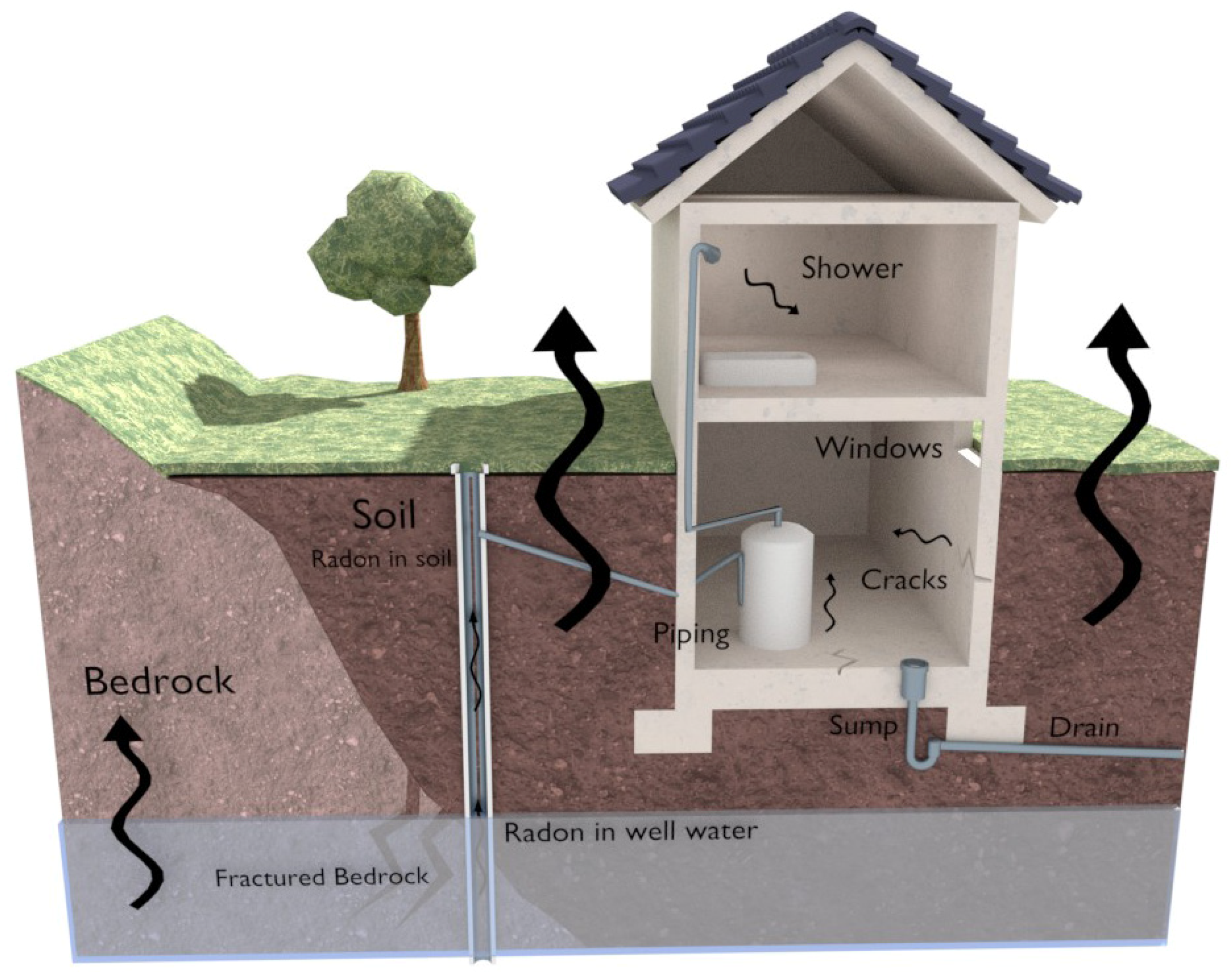
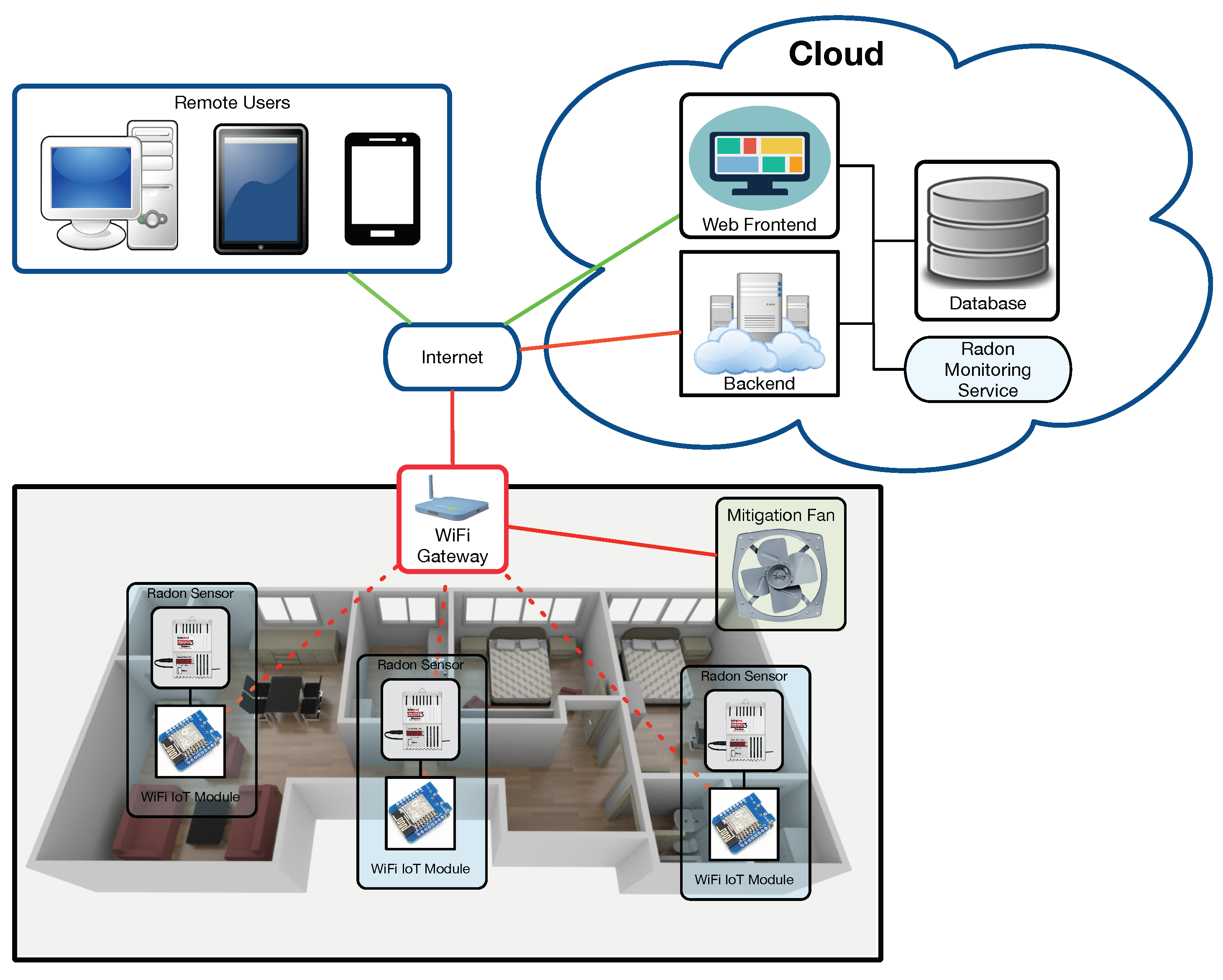
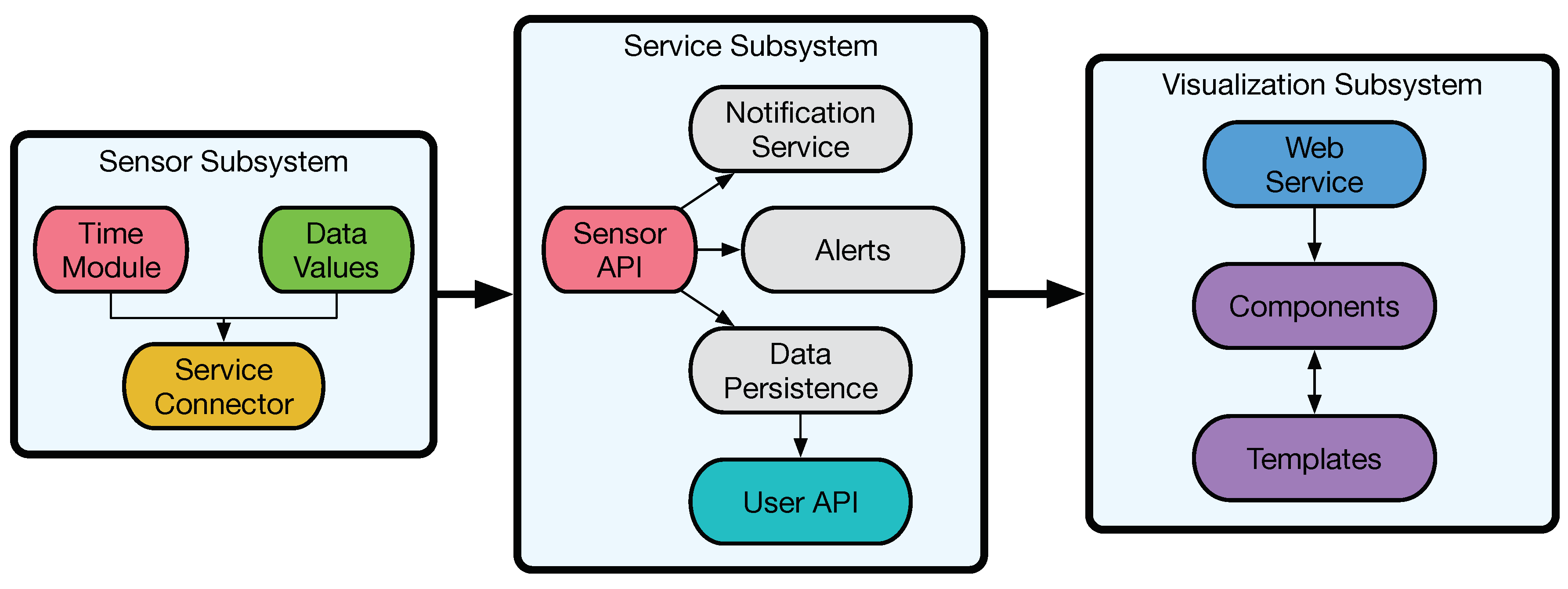

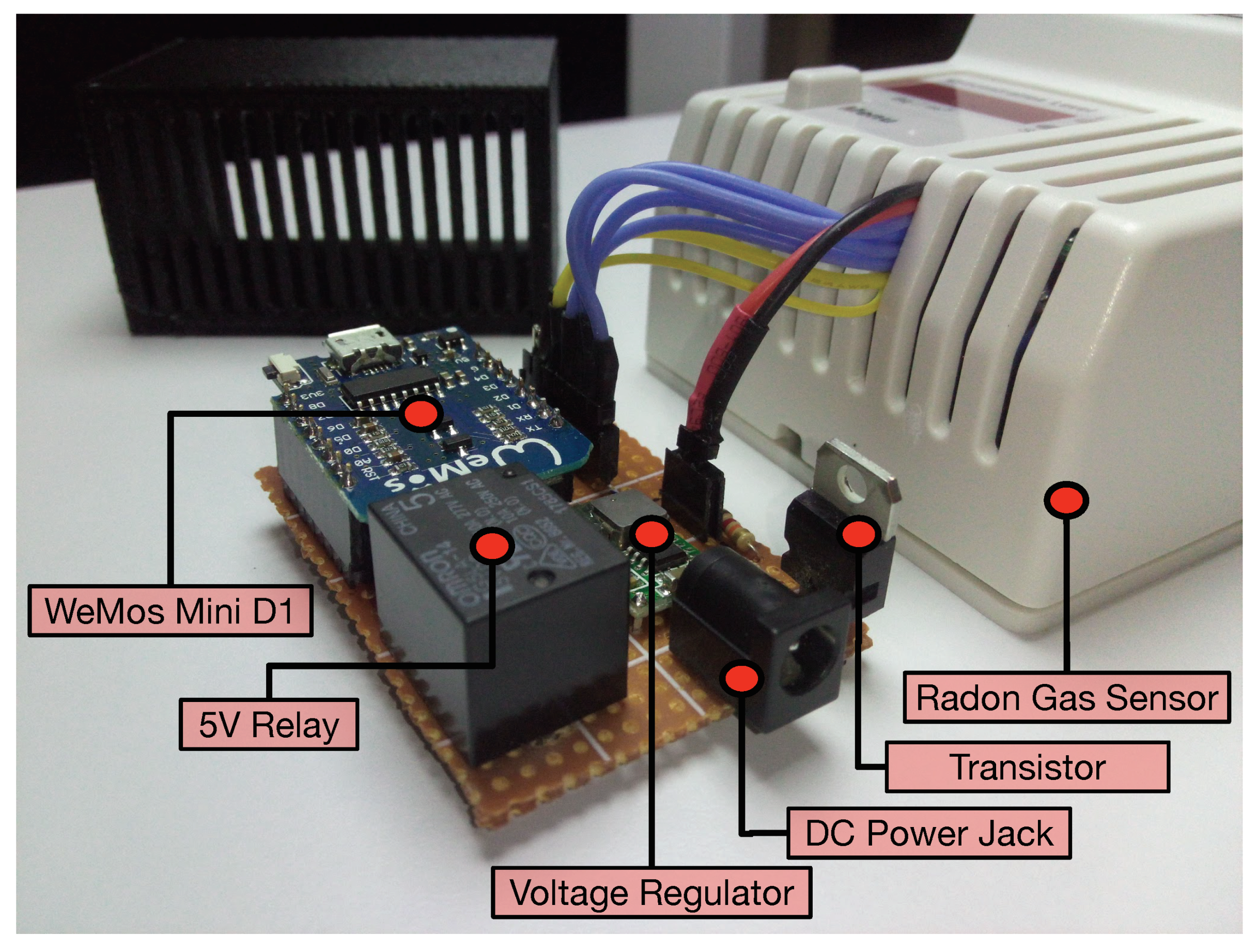

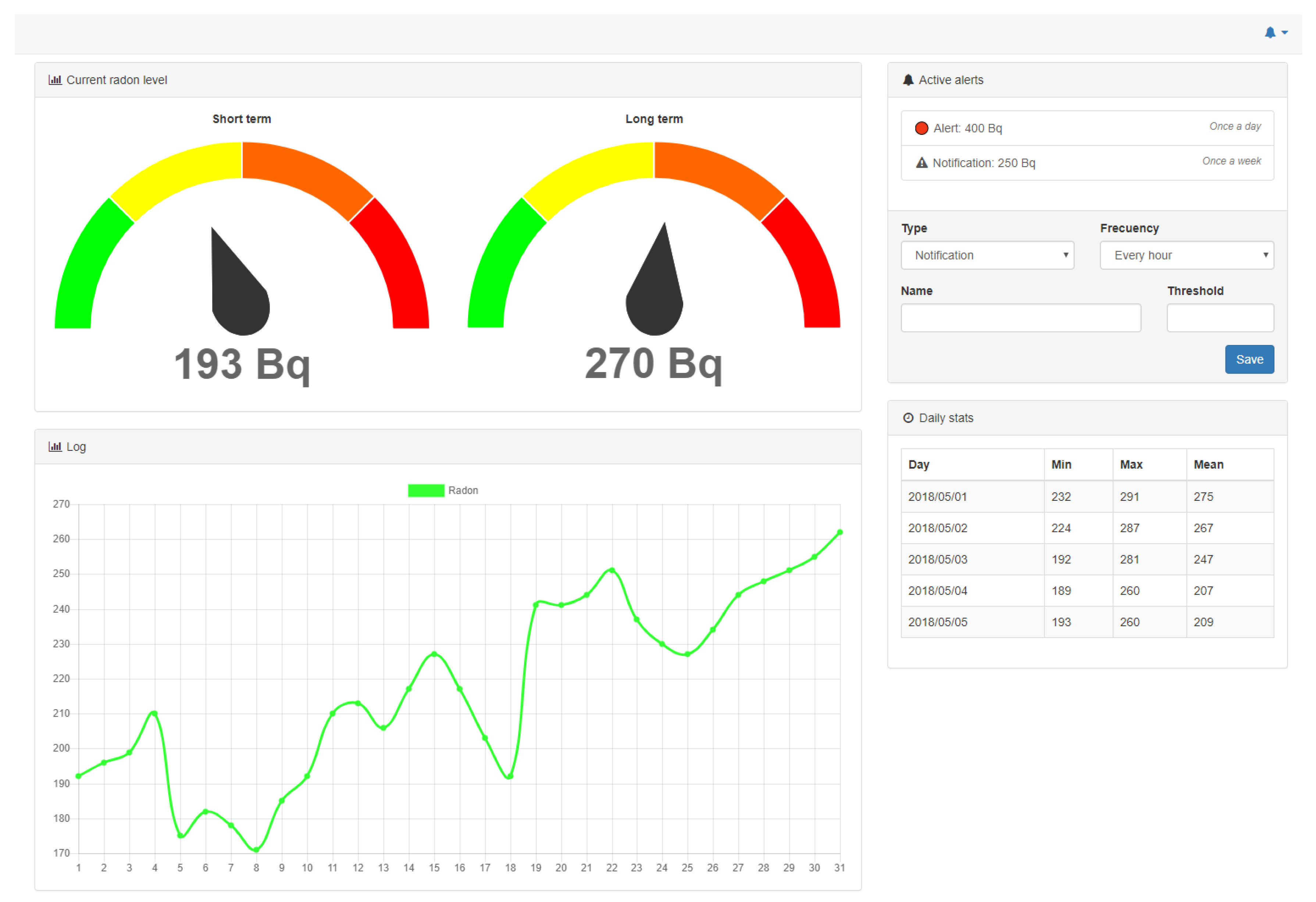
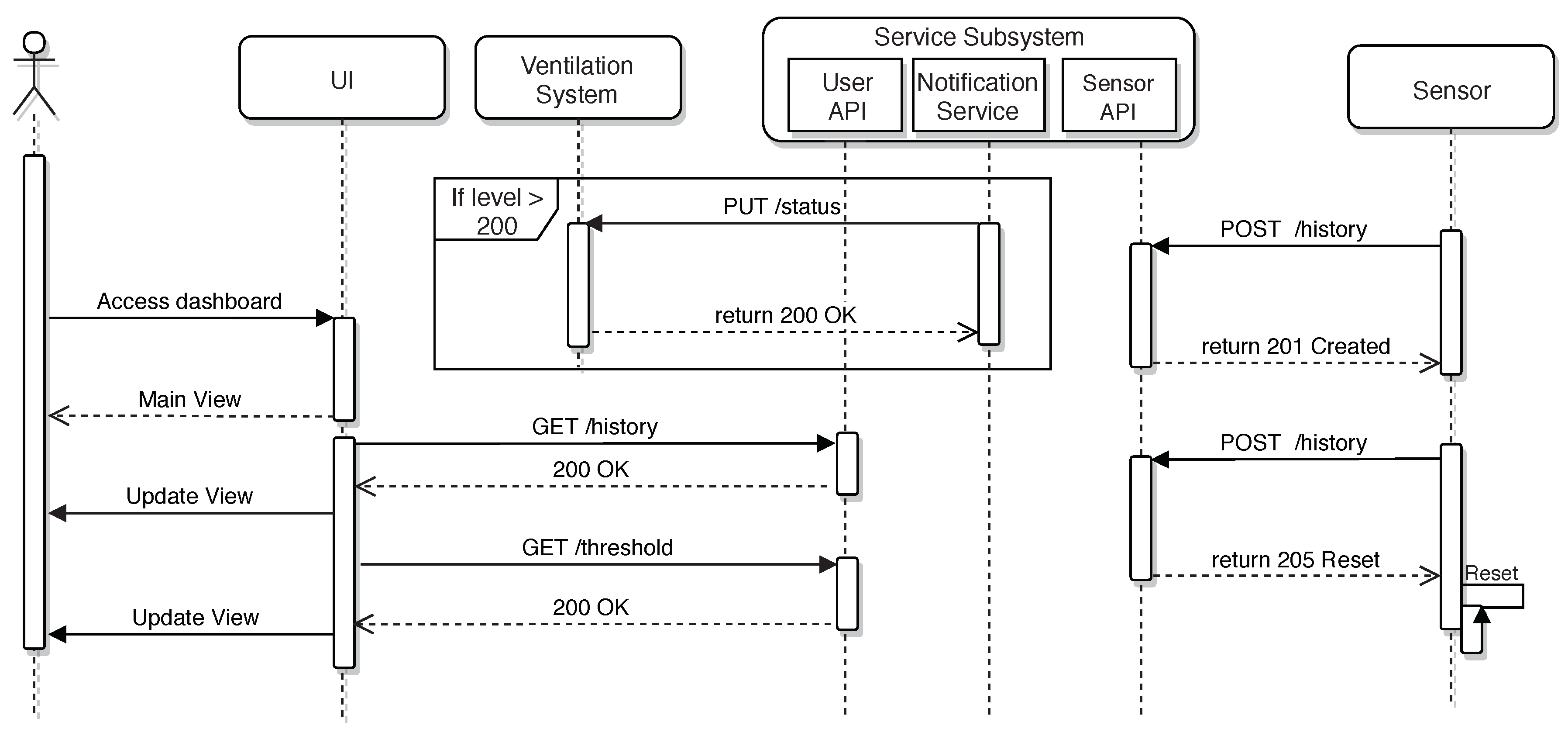

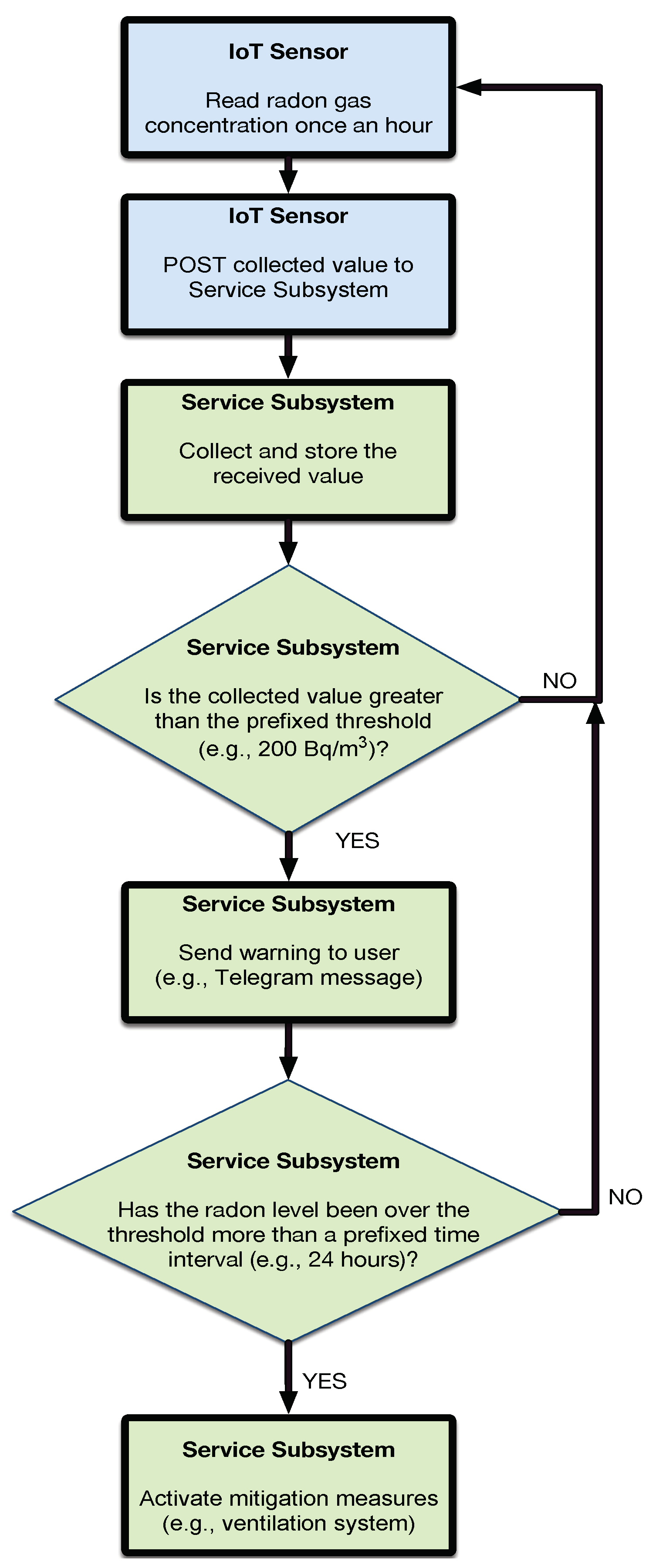
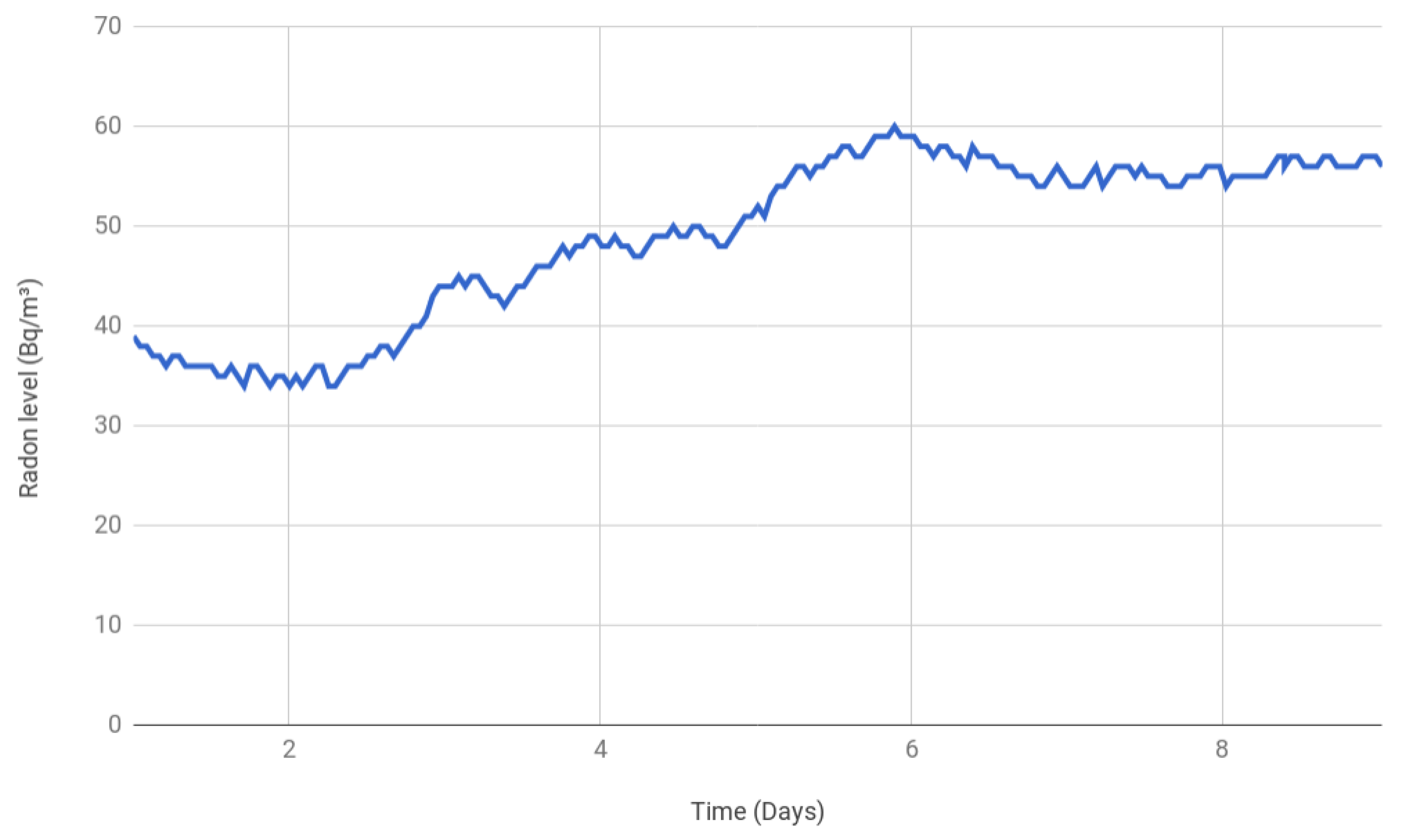
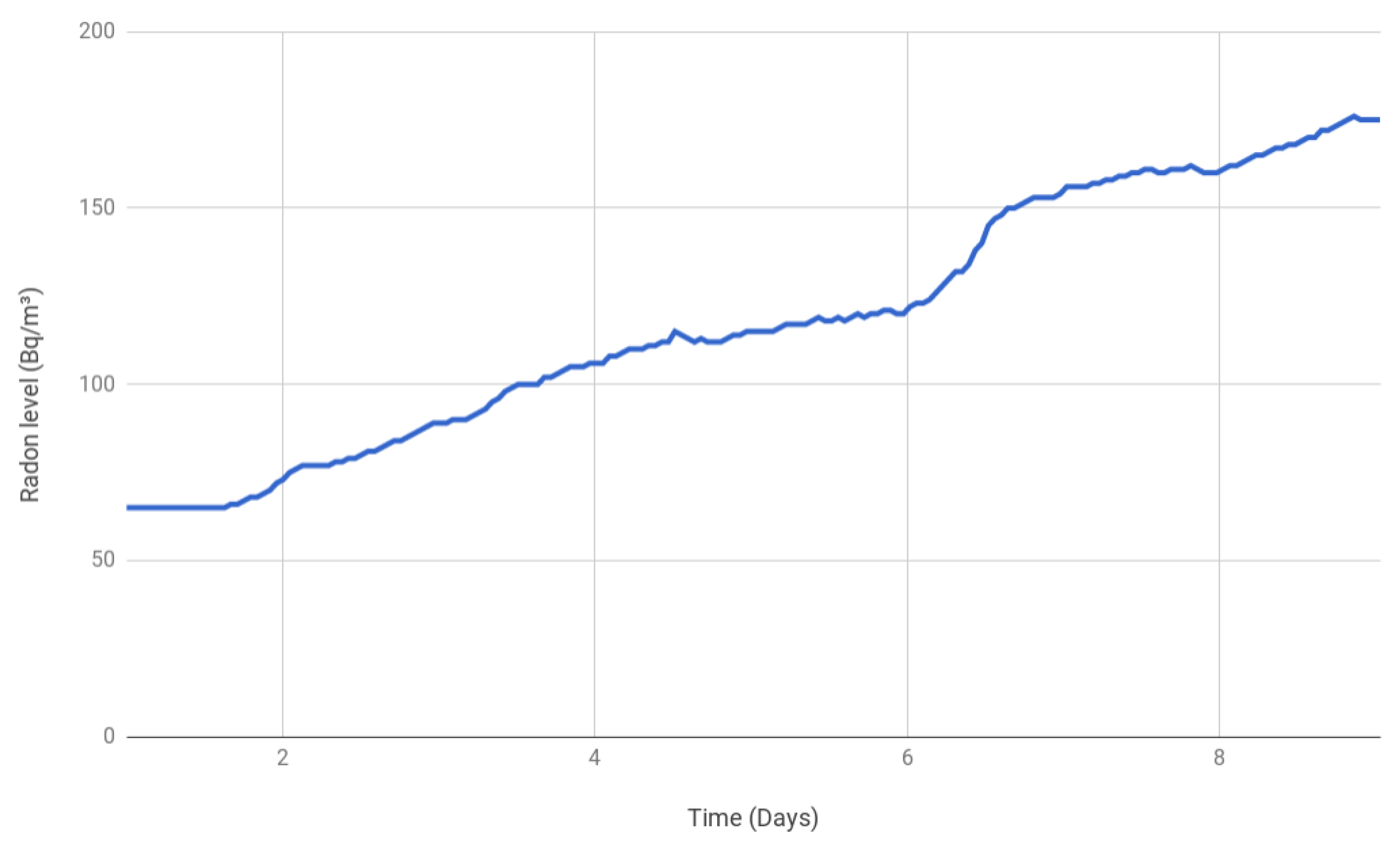
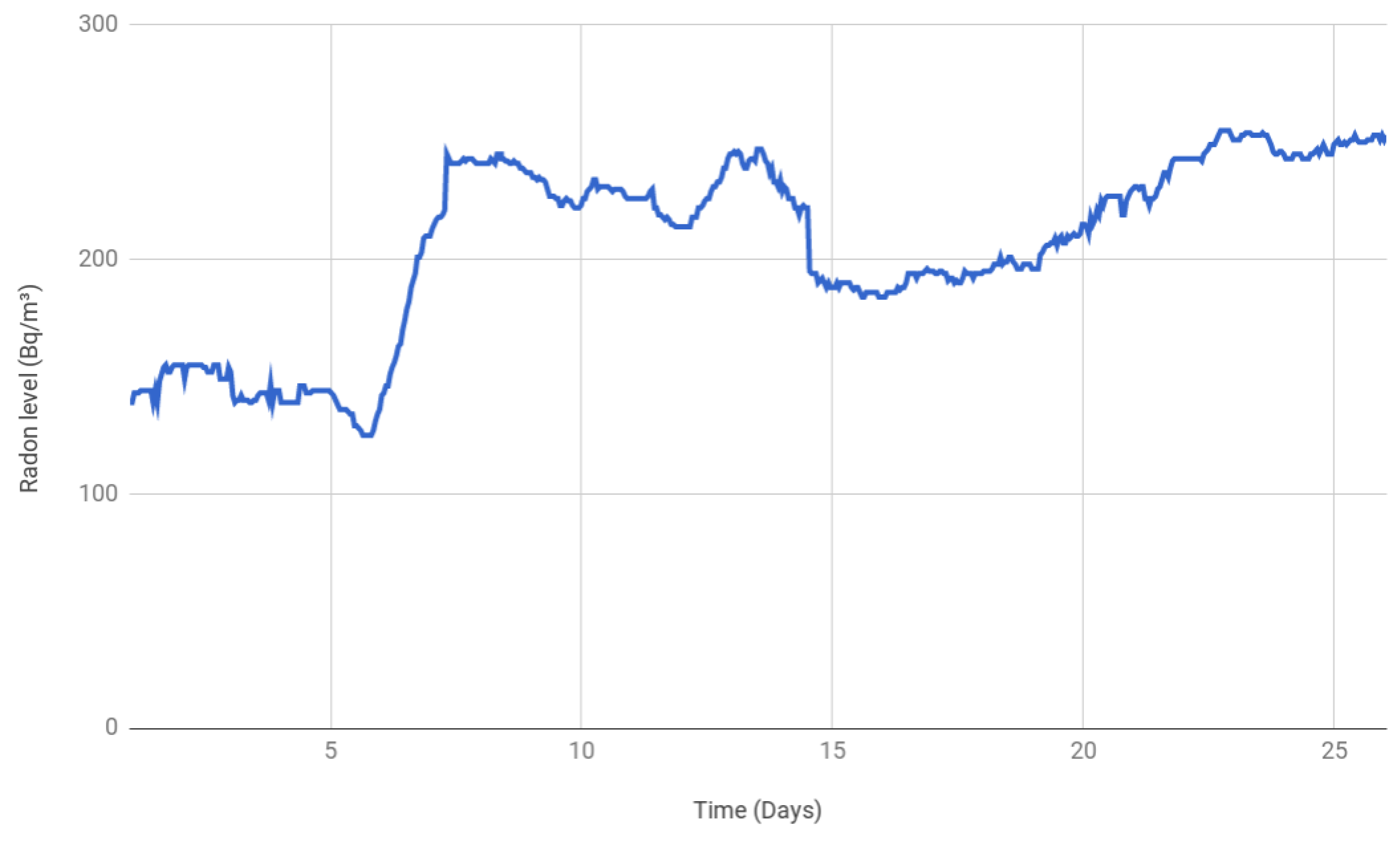
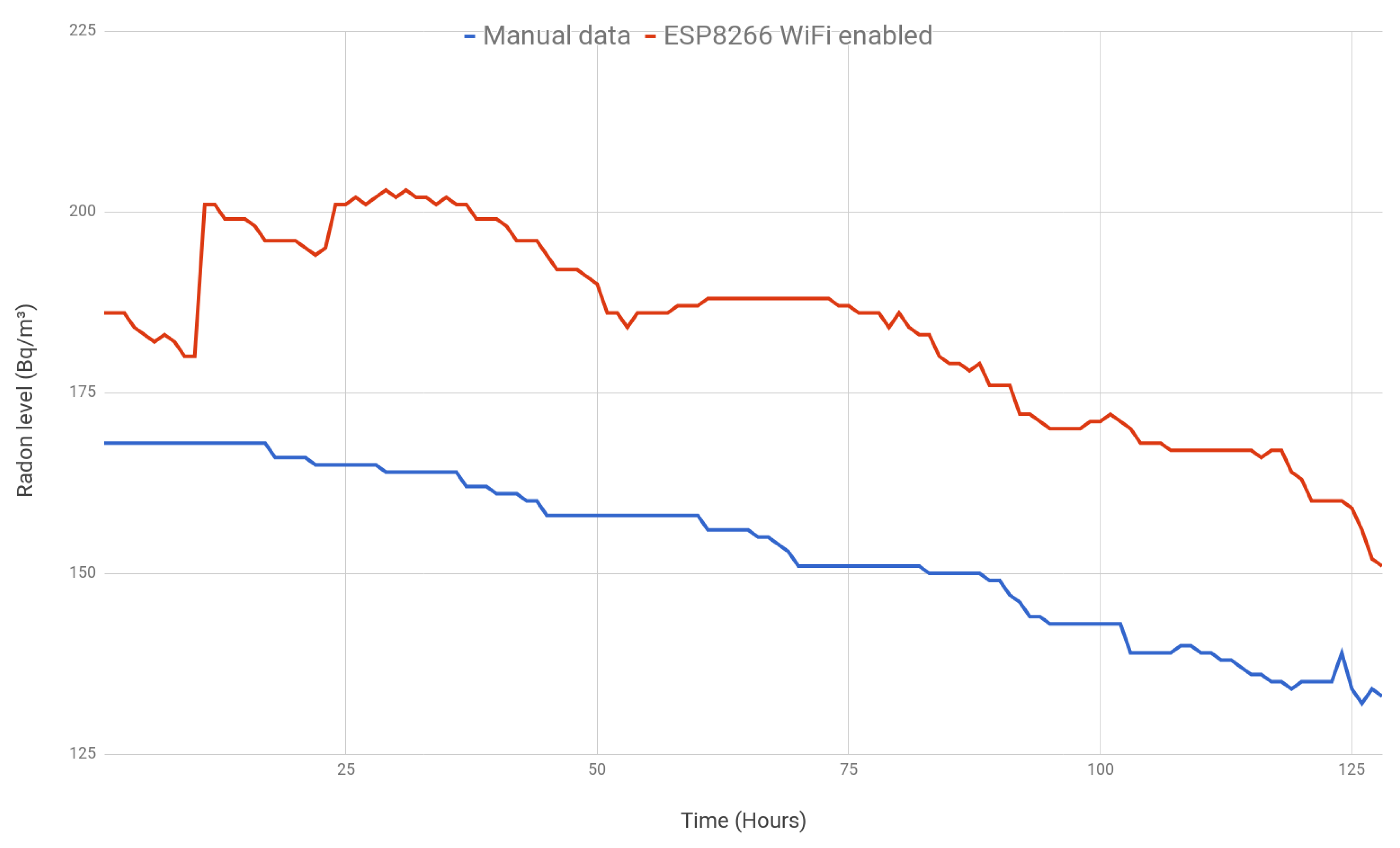
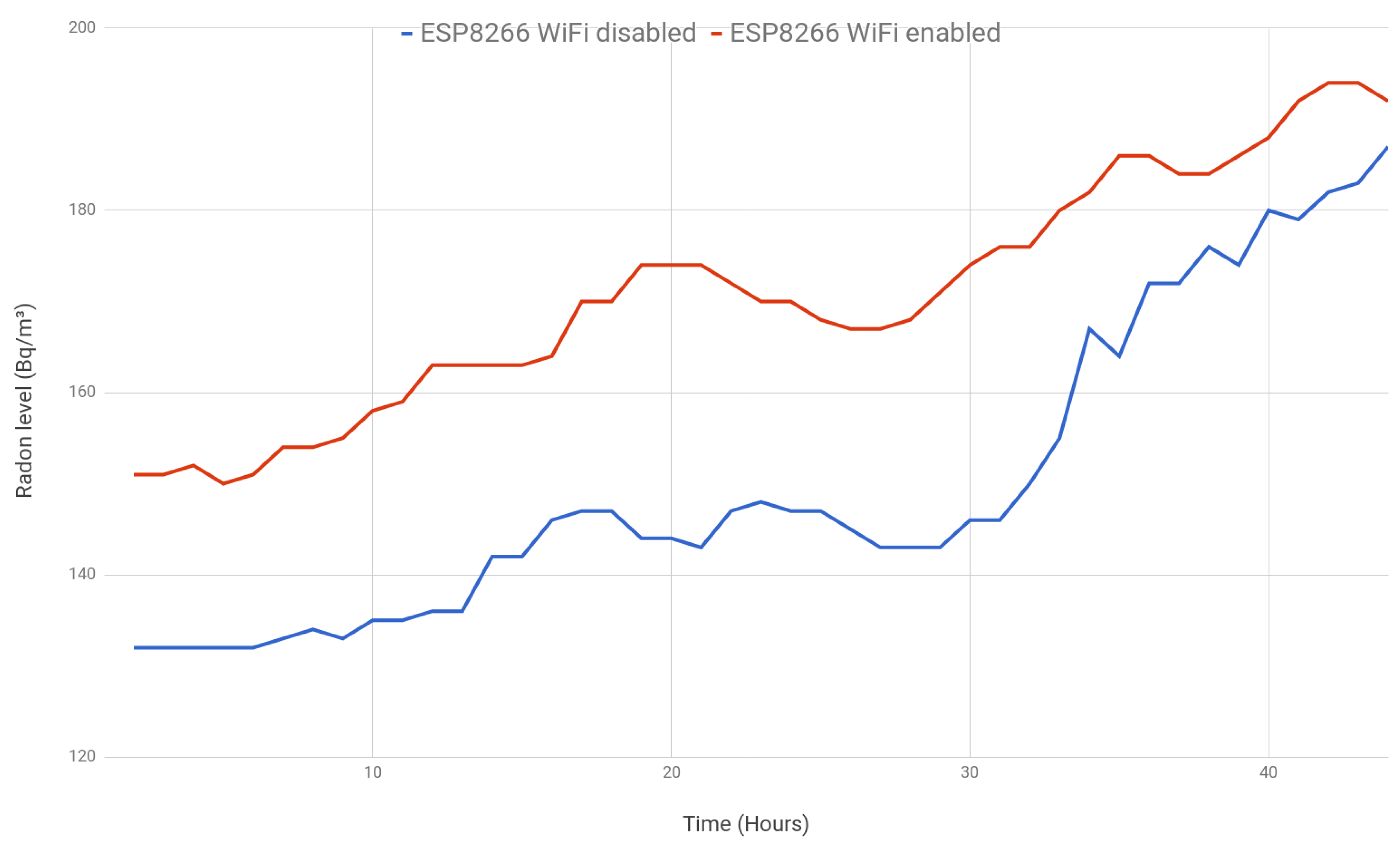
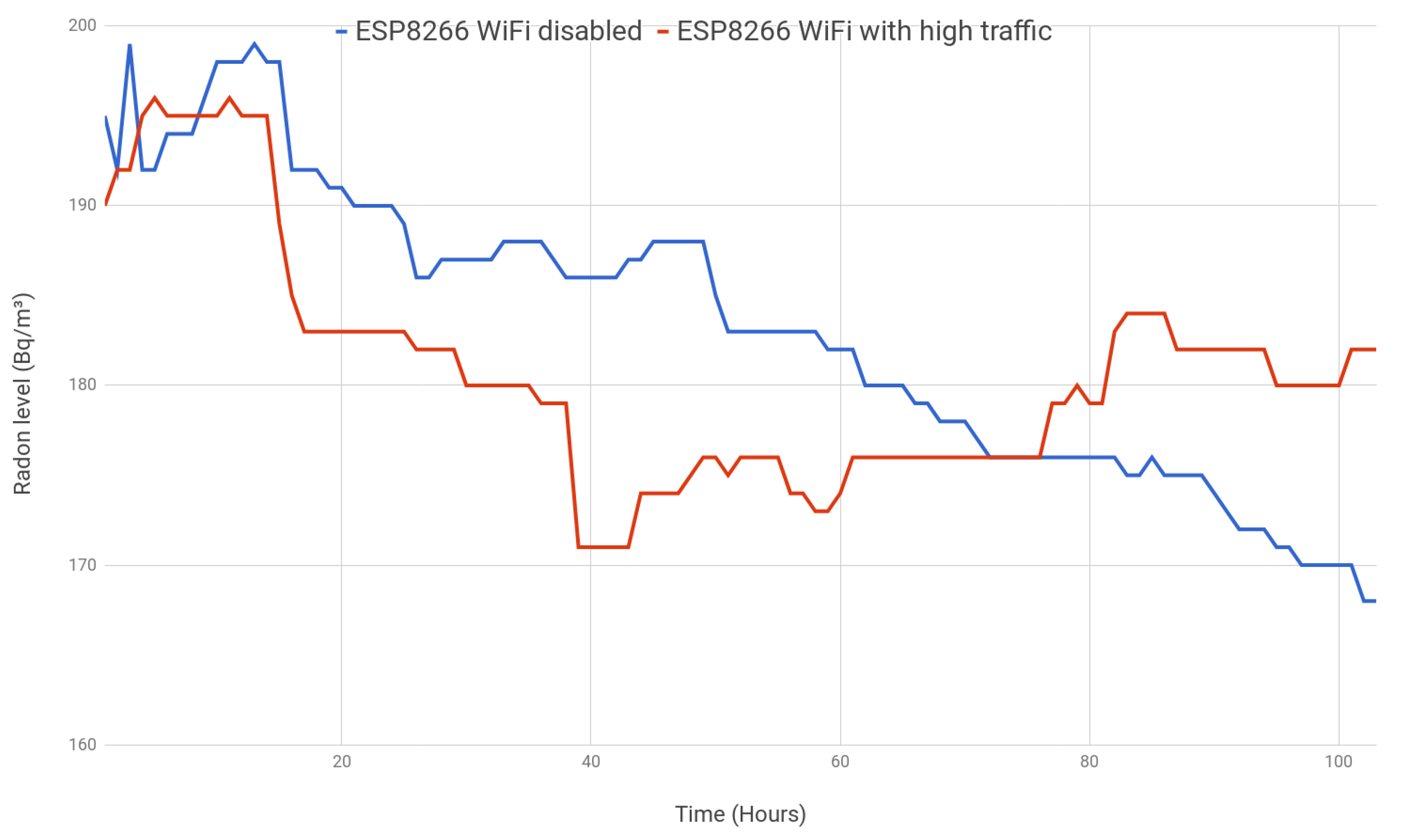
© 2018 by the authors. Licensee MDPI, Basel, Switzerland. This article is an open access article distributed under the terms and conditions of the Creative Commons Attribution (CC BY) license (http://creativecommons.org/licenses/by/4.0/).
Share and Cite
Blanco-Novoa, O.; Fernández-Caramés, T.M.; Fraga-Lamas, P.; Castedo, L. A Cost-Effective IoT System for Monitoring Indoor Radon Gas Concentration. Sensors 2018, 18, 2198. https://doi.org/10.3390/s18072198
Blanco-Novoa O, Fernández-Caramés TM, Fraga-Lamas P, Castedo L. A Cost-Effective IoT System for Monitoring Indoor Radon Gas Concentration. Sensors. 2018; 18(7):2198. https://doi.org/10.3390/s18072198
Chicago/Turabian StyleBlanco-Novoa, Oscar, Tiago M. Fernández-Caramés, Paula Fraga-Lamas, and Luis Castedo. 2018. "A Cost-Effective IoT System for Monitoring Indoor Radon Gas Concentration" Sensors 18, no. 7: 2198. https://doi.org/10.3390/s18072198







